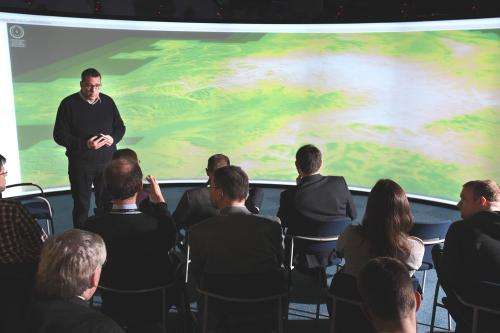Big data paves the way for big building and engineering projects

A new UK start-up company is about to revolutionize the way in which civil engineering and construction companies choose where to build, by telling them what's under the ground before they start digging. The information could potentially save companies millions of pounds by avoiding ancient burial grounds and other archaeologically important sites.
When any big construction project starts, or a major road or rail line is cut through the British countryside, there needs to be an archaeological investigation to ensure that historic sites are not destroyed. This can cost a company substantial amounts of money and add long delays in construction time.
Democrata, a data-analytics company based at the Harwell Campus in Oxfordshire, has been given access to the world leading high performance computing and big data analysis capabilities of the Science and Technology Facilities Council's (STFC) Hartree Centre at Sci-Tech Daresbury in Cheshire, to develop a way to predict the risk of such delays. The company won access to the Centre as part of a competition run in conjunction with the Open Data Institute, which enabled them to access to some of the UK's best big data analysts and facilities.
Lee Hannis, Business Development Manager for the Hartree Centre, says, "We have the facilities, the skills and the people that enable the project to work. The Democrata team recognised the business opportunities of using open data to create something commercially viable. The Hartree Centre has provided the people who can deliver the data analytics and visualisation to accelerate that process, to the point where Democrata now has something tangible to demonstrate to its customers."
Using the Hartree Centre's expertise and facilities, Democrata has mapped the whole of the UK using a 3D geovisionary programme originally developed for the British Geological Survey, and added a programme of predictive algorithms to identify where historic artefacts might still be found.
Democrata Chief Executive, Geoff Roberts, says, "We take disparate data sets, standardise them and link them together. With this project we visualise the output in geovisionary - so we plug all of the data into this mapping system and are able to fly over and through the UK landscape to see the level of risk in any location visualised in colour-coded layers."
The company has drawn data together from sources such as Defra, English Heritage, Scottish Natural Heritage, Ordnance Survey, the Land Registry and many more. Using the Hartree Centre's supercomputers and big data analytics platforms, its aim is to bring together vast amounts of disparate data created for one specific purpose and make it accessible to companies that do not currently use data and analytics to help plan their programmes of work.
In collaboration with environmentalists, academics, archaeologists, impact managers and engineering solutions providers, the Democrata concept is also being further developed for a number of different market sectors – for example, the different stakeholders and phases of a construction project, and identifying important archaeological areas that should be protected.
"We can help companies move into parts of the market that they are currently not so strong on", says Geoff Roberts. "We do the conceptual work using open data and the Hartree high-performance computers to predict exactly what will happen if they want to build something in a specific location. It helps the company to design and manage their project in the most efficient and cost-effective way."
Susan Smith, Head of STFC's Daresbury Laboratory, which houses the Hartree Centre, says, "It's gratifying that STFC has been able to help Democrata to deliver their business concept through the Hartree Centre's facilities and skilled people. The concept will not only benefit the companies which use it but will, in the longer term, also have a positive impact on the UK's economy and cultural heritage."
Provided by Science and Technology Facilities Council




















